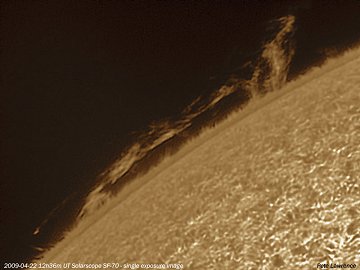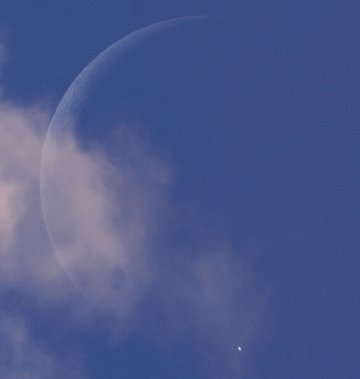| FADING SUNSPOT: New sunspot 1015 emerged yesterday to break a string of 25 consecutive spotless days. It was a short break. Less than 24 hours after it appeared, the tiny sunspot is already fading away. SURGING PROMINENCE: Every clear day, astrophotographer Pete Lawrence of Selsey, UK, scans the limb of the sun for photogenic prominences. "This morning I spotted a rather odd looking one," he says. "I've never seen anything quite like it before." This photo shows the view through his SolarScope SF-70: 
The twisting, swirling maelstrom underwent many changes in the hours that followed Lawrence's first sighting. "At one point I could see real time movement on my computer screen," he says. "It was amazing!" Apparently, even the quiet sun has something to offer. If you have a solar telescope, take a look. VENUSIAN ECLIPSE: Earlier today, people in western parts of North America witnessed an eclipse of Venus by the crescent Moon. Venus was half-covered when Rich Swanson of Sierra Vista, Arizona, took this picture: 
Photo details: Canon 20Dh, Stellarvue 102ED, 1/800 sec, ISO 400
"The sun was rising quickly, but who cares!" says Swanson. "The eclipse was visible in daylight." Hours later, Venus and the Moon are still close together. Readers, if the sun is shining where you live, go outside and look west of the sun for the crescent Moon. Found it? Scan the sky nearby for Venus. Binoculars help, but if you use optics, be sure the dangerously-bright sun is hidden behind a hill or tall building. Venus and the Moon are pretty, but you wouldn't want them to be the last thing you ever see. more images: from Jeff Stone at NASA's Mission Control parking lot in Houston, TX; from Ron Wayman of Tampa, Florida; from Thad V'Soske of Grand Valley, Colorado; from Mark Staples of Waldo, Florida; from Steve Riegel of Santa Maria, CA; from Barbara Harris of New Smyrna Beach, FL; from William Robb of Phoenix, Arizona; from Pete Lawrence of Selsey, West Sussex, UK; from Delores Browning of Rocksprings, Texas; from Peter Lardizabal of St Johns, Florida; from James Champagne of Baton Rouge, Louisiana; from Chuck Morlan of Frenchglen, Oregon; from William Robb of Phoenix, Arizona;
April 2009 Aurora Gallery
[previous Aprils: 2008, 2007, 2006, 2005, 2004, 2003, 2002]
Explore the Sunspot Cycle | 
